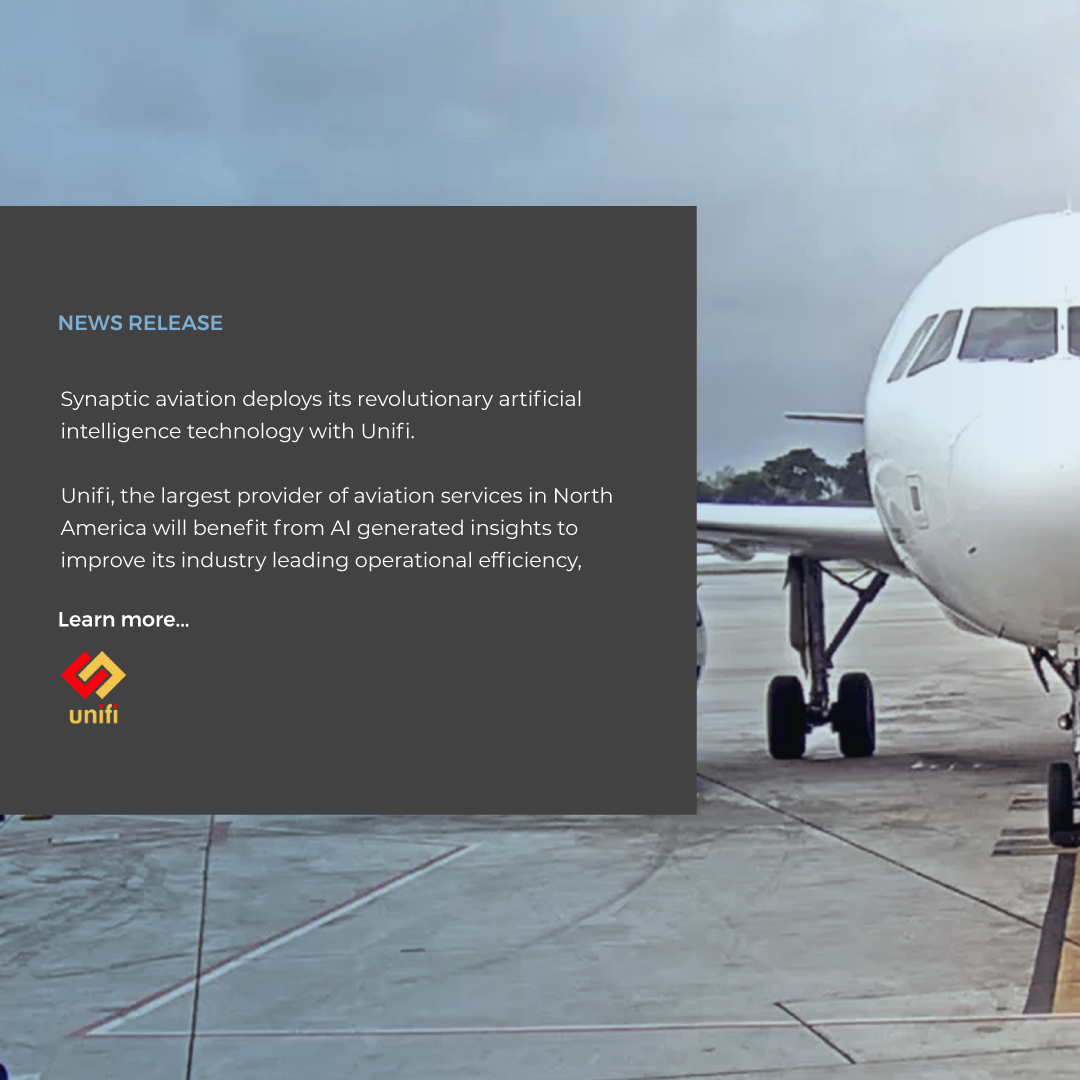

Groundbreaking Partnership with Leading Aviation Services Provider, Unifi, set to Improve Safety, Efficiency and Compliance
MIAMI, FL – January 12, 2022 — Synaptic Aviation launched its revolutionary Artificial Intelligence (AI) technology to provide cutting edge, unprecedented visibility into ground operations for the aviation industry. In partnership with Unifi (formerly DAL Global Services (DGS)), the largest provider of aviation services in North America, the two have signed a service agreement with the goal of improving Unifi’s industry-leading safety and on-time performance facilitating efficient aviation operations and a seamless customer experience.
Synaptic Aviation’s revolutionary AI platform produces smart, usable data that tracks activity and procedural compliance from start to finish while creating a real-time log of events. Historically, customers have been limited by the manual aspect of data gathering. This never-before available data gives the customer control of turnaround activities allowing them to prevent avoidable service failures and become predictive over time.
“At Synaptic Aviation we are passionate about pushing the limits of AI to solve common operational challenges that ground service providers, airlines and airports face every day,”
“Our solution is pioneering and delivers results within weeks.”Juan M. Gómez, CEO, Synaptic Aviation.
Synaptic Aviation tracks thousands of flights and provides key operational information like average turn time, gate utilization, mandatory foreign object damage (FOD) prevention walks, ground power unit (GPU) connection times, jet bridge status and more. In addition to the operational metrics being measured, Synaptic Aviation provides key compliance reports to help Unifi maintain safety measures around the aircraft.
“At Unifi, we’re always looking for ways to improve operations and safety for both our customers and employees,” said Brian Bartal, SVP of Safety for Unifi. “Synaptic Aviation provides an innovative way to further reduce human error.” The partnership focuses on improving training, follow up, compliance and meeting airline designated standards for connections and first bag out.
The AI technology minimizes avoidable disruptions and service failures while aircraft are being serviced on the ground. In addition, Synaptic Aviation improves safety and efficiency, helping to minimize injuries and create a reliable operational environment.
In a world with continued air travel challenges, advanced AI and computer vision have the capability to reduce avoidable delays, reduce CO2 emissions and lower operational costs.
“The aviation industry will never be the same,” said Gómez. “AI enables a type of visibility that gives our customers every piece of information they need to change the behaviors that cause service disruptions and unsafe working conditions. The result is a safe, reliable operation, a seamless customer experience, and an increase in customer loyalty.”
ABOUT SYNAPTIC AVIATION
Synaptic Aviation is an Artificial Intelligence (AI) software company that utilizes innovative technology to serve its large and growing customer base. Based in Miami, FL, the company combines its accurate, scalable software solutions with its understanding of the aviation industry to provide its customers information to improve safety, compliance, and efficiency. The AI-powered solutions developed and deployed by Synaptic Aviation optimize operations for airports, airlines, air cargo, and ground handling companies.
ABOUT UNIFI
Unifi is the largest aviation services provider in North America servicing more than one million flights each year. With over 20,000 valued employees across more than 200 locations, Unifi provides a full range of above and below wing services including ground handling, cabin services, passenger handling, security, facility, cargo services, ground support equipment maintenance, and more to most major US-based airlines, airports, and cargo providers. Unifi’s vision is to be the most respected company by providing an exceptional experience getting aircraft and passengers to their destination, safely. Find out more at www.unifiservice.com.
ABOUT Argenbright Holdings
Argenbright Holdings is a privately held provider of workforce solutions in human capital-intensive industries headquartered in Atlanta, Georgia, with decades of experience in security, aviation services, and facilities services. Argenbright Holdings’ mission is to provide legendary service to their clients by delivering the personal attention expected of local service providers, as well as having strong processes, technology-driven solutions, and national reach. Find out more at www.argenbrightgroup.com.
MEDIA CONTACT
Alexis Aran Coello
Communications Lead
Alexis.Aran.Coello@synapticaviation.com
Download in PDF

